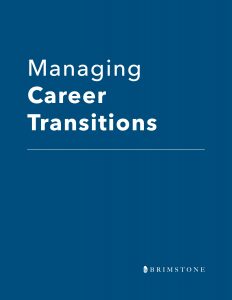Not in his goals but in his transitions man is great. – Ralph Waldo Emerson
Managing your career is your responsibility. It is not something you can “come back to.” Instead, managing your career is something that needs to be done on an ongoing basis. Those who consistently manage their career are more likely to achieve their professional and career goals than those who don’t.
To manage your career, you must be able to manage change and transition. In his seminal work, Transitions, William Bridges distinguishes between change and transition. Change is situational: promotion, marriage, divorce, job loss. Change can be brought on by choice, promotion, or forced upon you, being fired. While transition is the inner psychological process that people go through as they internalize and come to terms with the new situation that the change brings about. In other words, “inner reorientation and self-redefinition that you have to go through in order to incorporate any of those changes into your life.”
The ability to manage change and transition has a direct and positive impact on your career and your career progression.
Periods of transition provide an opportunity to reflect, reevaluate, and learn. They provide the opportunity for you to assess progress made, recognize strengths and weaknesses, and identify the skills and knowledge that will help you progress and succeed.
Bridges outlines that every transition begins with an ending, followed by a “neutral zone” and, eventually, a new beginning. These three phases will vary in duration and difficulty, depending on the situation and the individual in it, but all must be experienced, and in this order. The ending process is invariably painful because it requires that you accept that something has come to a close; this is a process of letting go. The neutral zone typically creates confusion, a sense of in-betweenness, as you struggle with the emptiness of knowing something has ended yet being unsure what comes next. This is the time when you gradually transform into “the person you need to be to move forward in your life.” The new beginning typically comes about after you’ve come to understand your real longings and generated enough motivation to take action. Even so, the new beginning may seem to arrive by chance, out of the blue.
“The transition process,” says Bridges, “requires not only that we bring a chapter of our lives to conclusion but also that we discover whatever we need to learn for the next step. We need to stay in transition long enough to complete this important process, not to abort it through premature action.”
The following five steps can help you successfully manage a career transition.
Assess Yourself
While we spend time trying to understand others’ complexity, we often don’t spend time exploring our own complexity. As you work to create the best outcome during a career transition, take time to gain perspective. The more you understand who you are as a human being, the better you will be at selecting future work situations that will bring contentment and success.
When facing a transition, whether imposed upon you or self-created, assess yourself as a leader, follower, colleague, and employee. Ask yourself the following questions:
- What are your strengths and weaknesses as a leader?
- What are you great at? What are you bad at?
- What kind of work activities do you most enjoy – planning, organizing, creating, decision-making, etc.?
- What are the gaps in your experience that need to be filled to get to the next level?
- What kind of leader do you want to be?
When you answer these questions, be explicit and specific. Take the time to write the answers down in a journal or somewhere where you can refer back to them.
If a transition is imposed upon you, we recommend working with a coach who can effectively help you explore what happened. The objectivity of a coach can help you face inconvenient truths and maintain a balanced perspective. Questions to consider:
- What went wrong, what was going right?
- What did you achieve in your last role, and where did you fail?
- How and where are you culpable in the events that directly led to your departure?
- What was the political context for what was happening? What were you aware of, and how well did you manage the politics?
- How do the organization and your team feel about your departure? Why do they feel that way?
Be aware that as you explore what happened, you may unleash negative emotions. Emotion is inevitable; it’s human nature. Wading through your emotions will be a test of your perseverance. The combination of obsessing about losing a job, the force of the emotional rollercoaster, and our nature to seek explanations (and assign blame) – can provide a rich vein of perspective.
Define Your Leadership Model
Take the time to define your leadership model and to make it explicit. Like most leaders who are well into the span of their career, you probably do a lot unconsciously. Articulating and codifying your leadership model will help you better understand where you excel, your focus, and what you enjoy as a leader. This knowledge can help you filter new opportunities through the lens of your capabilities and interests.
Ask yourself the following questions:
- What’s your leadership model – how you think, how you lead, what processes do you use?
- What’s your framework around people and leadership –how do you identify, motivate, assess and develop talent? What kind of people do you tend to surround yourself with?
- How do you fix operational problems, political conflicts, interpersonal issues?
- How do you affect change?
- How do you define poor leadership?
- What do you want not to do?
Keep Track of Achievements and Accomplishments
Even if you’re not actively looking for a job, take a few hours each year to update your resume. It’s a good exercise as it forces you to record your major achievements annually. Share the draft with a coach or colleague and ask for feedback – another set of eyes can help you see or frame accomplishments in a way you might not do independently.
Assess Your Value
Every few years, reach out and have an informal talk with a headhunter. The goal of the conversation is to have the headhunter help you assess your market value, help you to understand whether the job or level you’re hoping to attain next is within your reach now, and what experience gaps need to be closed.
This is also a good conversation to have with mentors, external executive coaches, and others in your network. Push yourself to have these kinds of conversations regularly – maybe not annually, but certainly every few years.
The key is to have these conversations before you need to look for a job.
Network
Invest time and energy into building and maintaining your network. Tools like LinkedIn can help you build and maintain your network, but don’t mistake presence for action. If you want to ensure good career opportunities come your way, you can’t be passive. It requires effort to purposefully build your network, maintain it, and add value to people within your network.
Managing your career is your responsibility. To manage your career, you must be able to manage change and transition. And, you need to take ownership – managing your career is your responsibility. You are responsible for creating a plan that will help you to be the leader you want to be.








